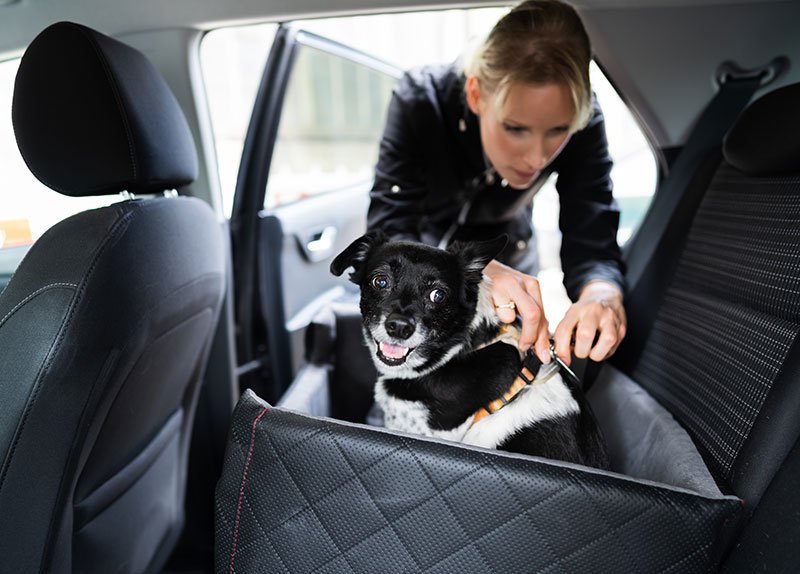

The first time you put your new best friend in your vehicle is an exciting moment. It’s also a moment to think about her safety, not just on this first trip, but ongoing. Over the years, the two of you will no doubt share many a car ride, so if possible, it’s good to start as you mean to go on. For guidance, consider what our canine behavior expert sees as the pros and cons of each method.
My social media feed is full of dogs (that’s why I still love social media!) and more than ever, I’m seeing tons of photographs of people with their newly adopted shelter pups. Since the pandemic began in early 2020, it’s become common for people to post photos of themselves driving their soon-to-be best friends home. Seeing dogs on the way to their forever homes is a happy sight, one that’s hard to beat.
It would be even better to see all those dogs headed home in the safest, most comfortable way possible. Here are the ways I have seen dogs being transported in the last couple of weeks on social media, with what I consider to be the pros and cons of each method.
Being held by a passenger.
Contents
On the plus side, physical contact can accelerate the development of close ties between dogs and their people. For dogs who enjoy it, being held makes them feel secure. Dogs who prefer more personal space tend to find it less welcome. When the dog is being held, she is prevented from moving around the vehicle, possibly hurting herself or distracting the driver, which can lead to a dangerous situation. On the other hand, humans can’t prevent dogs from becoming missiles in the event of an accident or other sudden stop, so overall, this is not the safest way to transport a new dog home. (Remember, for safety’s sake, the driver should not be the one to hold the dog.)
GET THE BARK NEWSLETTER IN YOUR INBOX!
Sign up and get the answers to your questions.
In a crate.
Confined in a crate is a far safer way for dogs to travel, and I’m a big fan of using them. On the plus side, in addition to the safety factor, crating the dog prevents potential mess-makers (vomit, urine, slobber or hair, for example) from getting all over the rest of the car. On the downside, some dogs absolutely panic in a crate or are so distressed by being in one that it may not be worth it to insist.
Restrained with a harness and seat belt or zipline.
These options have the benefit of safety because the dog can’t go flying in the event of an accident or sudden stop, and can’t run amok in the car. Being tethered to a small area helps keep the dog (and everyone else on the road) safe. This method of restraint will work for most dogs, even those who are panicky about confinement. Only a few really freak out in a harness, although some do fuss about it a bit. With these forms of restraint, a dog can snuggle up to a passenger, which often gives comfort to a dog heading into the great unknown (unknown, at least, from the dog’s perspective).
On the seat.
Many dogs are happy to be on the seat, but without some form of restraint, they’re potentially exposed to danger. The dogs seem relaxed in this situation, but it’s not relaxing for me to see these pictures. However, if a dog is going to be transported loose in the car (which I don’t recommend), being on the back seat is safer than being on the front seat.
On the floor.
This is probably more common than we think, but (obviously) it’s hard to tell if that’s the case unless you’re in the car. Riding on the floor of a car behind the front seats is safer than being in the front, where the dog might distract or interfere with the driver. It’s also somewhat safer than sitting on the seat, but since the dog is not secured, there’s still a risk with this method. If a dog chooses to be on the floor, she may do so because it feels to her like a more secure space. This suggests that a crate may be a good option for this particular dog, now or in the future.
Behind a dog guard.
A guard that blocks off the back section is a great option. This prevents the dog from being loose in the car, and from flying into (or through) the windshield in the event of an accident or a sudden stop. Many dogs are comfortable in such a setup, and it’s a good long-term transport strategy. If used when the dog is being brought home from the shelter, it’s nice to have a person in the back seat to offer company and comfort. But even if you’re driving your new best friend home by yourself, this is a safe option for you and for the dog.
In the back of a pick-up truck.
This is the worst possible option, especially for a dog who has not yet developed a bond with you. Practically anything could cause the dog to freak out and try to escape. Shelter dogs’ histories are usually pretty scant, which means you have no way of knowing if a truck bed is a second home for your new dog or so unfamiliar that it could cause her terror, especially once you’re on the road.
That having been said, however you choose to transport your new dog, please offer her a “Welcome home!” and a little loving from me!